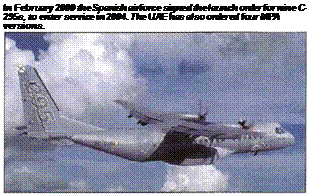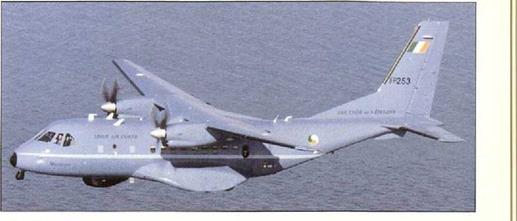CASA (Airtech) CN-235 and C-295 Tactical transport aircraft
|
|
T |
he CN-235 igh: tact cal transport was designed and developed under a joint initiative by Spain’s CASA and Indonesia’s IPTN, They founded the Airtech concern in 1980 to develop a robust aircraft that could serve both as a mi’lta^y transport and a regional airliner. The CN-235 has all the classic elements of a nr. il tary transport, including a rear – loading ramp, high wing ano rough-field landing gear. The aircraft Is powered by a pair of proven General Electric CT7 turboprops, and is capable of dropping troops and supplies from its side doors and rear ramp. Military design features predom neted in the CN-235 and it had ittle success in the com – mercia market, However is has become popular with air forces worldwide, fitting into a niche below the capacity and costs of the C-130 Hercules.
Two prototypes were built with CASA’s example making the first flight on 11 November 1983. The irit:al production variant was the CN-235 Series 10, powered by CT-7A engines. Military variants were designated Cll-235M-I0s and ai’craft were delivered to Botswana, Indonesia, Saudi Arabia, Spain (as the VIP-configured T.19A) and the UAE The improved CN-235M-100 followed, powered by uprated CT7C engines. The Series 100 introouced a major step forward in performance, IPTN-built a’rcraft were designated CN-235IVl-110s. Customers nclude Chile, Ecuador, France, Gabon, Indonesia, Ireland, Morocco, Oman, Papua New Guinea, South Africa, South Korea, Spain (T.19B), Turkey and the UAE.
The CN-235M-200 (IPTN -220) introduced higher operating weights and still bettei performance. It has been acquired by Indonesia and Malaysia.
Turkey signed a licence-p’oduction deal in 1990 to bu Id 50 of its 52 aircraft. These were delivered between 1992 and 1998. Manufacturer TAI is now working on a maritime patrol version for Turkey. CASA developed its own maritime patrol version, the CN-235MP Persuader which is in service in Ireland. IPTN has also been working on its own maritime patrol version, the CN-235MPA, but its development has been slow and only a prototype has been built.
In 1997 CASA announced the independently – developed C-295. The C-295 Is 10 ft A in (3,05 m) longer than the CN-235, ncreasinc its payload by over 50 per cent. The C-295 is powered by two Pratt & Whitney Canada PW127G turboprops, and is fitted with a Sextant Topoeck EFIS cockpit. A technology demonstrator made its maiden flight on 28 November 1997 and the first production-standard C-295 flew on 22 December 1ЭЭ8.
 Specification CASA (Airtecli) CN-235-100 Powcrplant: two l394-kW(1B70-hpJ General flectric CT7-9C turboprops Dimensions: span 25.81 m (84 ft 8 in); length 21.43 m (70 ft 2V in); height 8.1 (5 m (?G ft 10 ini: Weights: empty equipped 8800 <g (13,400 lb); maximum take-off 160(13 kq (35773 1Ы Performance: maximum cruising speed 422 kith (76? mpf); maximum rate of climb at sea level 579 m (1,900 ft) per minute; service cei’ing 6860 n 122,500 ft); maximum range 4352 km (2704 miles) with a 3550-kg (7.826-payload)
Specification CASA (Airtecli) CN-235-100 Powcrplant: two l394-kW(1B70-hpJ General flectric CT7-9C turboprops Dimensions: span 25.81 m (84 ft 8 in); length 21.43 m (70 ft 2V in); height 8.1 (5 m (?G ft 10 ini: Weights: empty equipped 8800 <g (13,400 lb); maximum take-off 160(13 kq (35773 1Ы Performance: maximum cruising speed 422 kith (76? mpf); maximum rate of climb at sea level 579 m (1,900 ft) per minute; service cei’ing 6860 n 122,500 ft); maximum range 4352 km (2704 miles) with a 3550-kg (7.826-payload)
Armament; MPA versions have two hardpoints under wing. Indonesian development aircraft fitted with Exocet or Harpoon missiles
|
|
|
|












